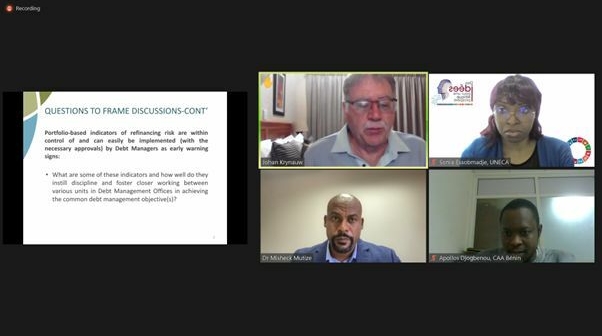
On April 13th, CABRI welcomed public debt managers from 15 African countries to the seventh network engagement meeting. Following recent sovereign defaults by at least two African countries amid continuing negotiations with the International Monetary Fund (IMF) and the rising spotlight on massive Eurobonds coming due for redemption starting as early as 2024 (according to Moody’s estimates), CABRI in collaboration with African Peer Review Mechanism (APRM) and United Nations Economic Commission for Africa (UNECA) explored how African governments are addressing roll-over, debt refinancing and fiscal risks related to Eurobond issuances. Country experiences from Benin and Sierra Leone were shared on the application of various active debt and risk management strategies such as debt exchanges (switches), debt reprofiling, other innovative liability management operations, and buy-backs in managing and/or reducing government refinancing risk. Lessons were also shared on key portfolios and other debt indicators Benin and Sierra Leone are implementing in monitoring and reporting on the performance of their debt portfolios against these indicators.
1. Setting the scene
Active debt management strategies/transactions such as debt buy-backs and debt exchanges/switches should ideally be part of the annual borrowing plan (ABP) or executed voluntarily in the normal course of local currency debt market reforms, which has the advantage of enhancing debt transparency and accountability. While debt buy-backs may require a government to run budget surpluses or in rare instances have surplus cash available, debt exchanges are cash neutral. This implies that government does not need to raise the entire cash upfront (as part of the funding program) to meet redemption obligations as the (shorter-dated) bonds about to redeem are exchanged for longer-dated bonds cash for cash. The cash ratio expresses the equivalent amount of the destination (new and/or longer-dated) bond for the source (or switched out) bond.
The interactive discussion highlighted other important features of the debt exchanges, i.e., while they are cash neutral, debt exchanges are not portfolio (or duration) neutral. If debt managers believe that duration is a better proxy for a cost measure/indicator, then an increase in duration owing to switching to the longer end of the yield curve will increase the cost or add a cost margin to the expected borrowing cost of purely financing the budget deficit (other things remaining the same). The (refinancing) risk, however, will decrease as the average term to maturity (risk indicator) of the portfolio lengthens (improves).
While the medium-term indicators of debt distress tend to be mostly risk indicators, the debt management objective underpinning the debt strategy emphasizes a reduction in the medium-term cost of debt. Therefore, in featuring the debt exchanges as part of the annual borrowing plan a fine balance will need to be struck between the cost reduction and risk reduction objectives. The reduction in refinancing risk and/or prospects of default should not be achieved at a perpetual cost to the government.
The interactive discussion also reflected on the creditworthiness effect of executing debt exchanges involuntarily. Often this results in credit rating agencies treating or otherwise classifying the debt exchanges as an event of debt default. The advice offered by the discussant to debt managers is that debt exchanges should not be utilised as a device to hide debt defaults or the inability by the government to meet payment obligations as they fall due.
2. Country Experiences
Benin embarked on a risk mitigation strategy underpinned by 3 pillars: (i) effective public finance management; (ii) improvement of Benin’s creditworthiness (credit standing) and (iii) proactive public debt management. Benin has successfully carried out several liability management operations, namely:
(i) 2018 domestic debt reprofiling operation which resulted in Benin being able to mobilise resources from international commercial banks over a 12-year period with an interest rate of less than 4%, thus achieving a total saving of approximately 52.4 million euros, which was used to finance social spending and Public Investment Programme;
(ii) 2021 two-tranche Eurobond issues of 11 years at interest rates of 4.875% and 31 years at interest rates of 6.875%, respectively. This was coupled with the liability management operation that enabled early repayment of 65% of the first Eurobond issued by Benin in 2019, which enabled Benin to smooth the public debt amortization profile while reducing the repayment of principal payments over the period 2024-26;
(iii) 2021 domestic debt reprofiling operation saw Benin completing an innovative operation to repay Treasury bonds issued in the West African Economic and Monetary Union (WAEMU) regional bond market for a total amount of 217.9 billion CFA Francs. The operation allowed the early repayment of debts contracted under less favourable market conditions and used to finance projects eligible for the SDGs.
Sierra Leone conducted 3 debt buybacks:
(i) External commercial debt buy-back in 1996, followed by the second one in 2009 under the Debt Relief Facility (DRF).
(ii) Domestic debt buy-back also in 1996 and augmented in 2002. The debt was successfully subscribed by domestic creditors and was categorised into three: Tender; Local Purchase Order and Sole Sourcing at discount rates of 45%; 35% and 15%, respectively.
(iii) 2017 domestic debt buy-back to clear domestic arrears.
In NPV terms, the stock of debt in Sierra Leone was reduced from US1,197.6 million at the end of 2005 to US 483.0 million at the end of 2006 after HIPC relief and to US 110.0 million after Multilateral Debt Relief (MDRI). The External debt dropped from over 220% of GDP in 2003 to about 43% of GDP in 2007 and in the long term, the NPV of debt-to-exports ratio was expected to increase gradually but remain below 70%. No new commercial debt has been contracted since HIPC and external creditors are mainly composed of bilateral and multilateral who offer concessional credits.
For inquiries, please email Jim Matsemela at jim.matsemela@cabri-sbo.org.